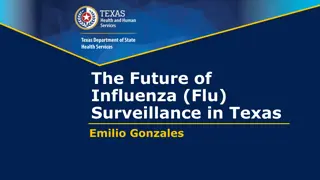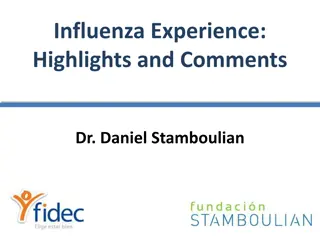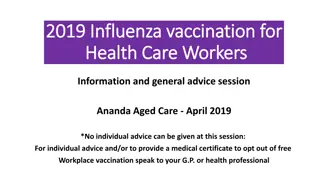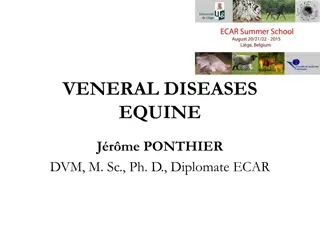Influenza A(H3N2)v at Jackson County Junior Fair 2022
Learn about an Influenza A(H3N2)v outbreak investigation at a fair. Understand the control steps taken and public health recommendations. Discover the partners involved and outbreak timeline details. Explore case definitions and surveillance methods. Popular
0 views • 14 slides
Impact of Highly Pathogenic Avian Influenza 2023 on South African Broiler Industry
The presentation by the South African Poultry Association sheds light on the detrimental effects of Highly Pathogenic Avian Influenza (HPAI) on the broiler industry in South Africa. Factors such as load shedding, water supply interruptions, and now, the outbreak of H7N6, have exacerbated the financi
4 views • 19 slides
Avian Influenza Overview and Outbreak History in South Africa
Avian Influenza, specifically Highly Pathogenic Avian Influenza (HPAI) outbreaks in South Africa, have been documented since 2004, affecting primarily ostriches and poultry. Wild bird transmission remains a concern, with risk factors such as rainfall, temperature, wetlands, and poultry movements con
2 views • 25 slides
United States Influenza Disease Burden by Season
Estimated influenza disease burden in the United States from the 2010-11 season through the 2022-23 season, including symptomatic illnesses, medical visits, hospitalizations, and deaths. The data provides insights into the impact of influenza over the years and preliminary estimates for the upcoming
8 views • 4 slides
Understanding Viral Diseases in Poultry: Newcastle Disease and Avian Influenza
Viral diseases like Newcastle Disease (ND) and Avian Influenza (AI) pose significant threats to poultry farming, impacting bird health and production. ND, caused by Avian paramyxovirus type 1, is highly contagious and manifests in various forms affecting birds' respiratory and nervous systems. On th
7 views • 24 slides
Update on Avian Influenza A(H5N1) Outbreak in the U.S.
Avian Influenza A(H5N1) has been detected in domestic livestock and a few human cases have been reported in the U.S. The CDC issued a technical report detailing the cases and their symptoms. No human-to-human transmission has been identified so far. The situation is being closely monitored and updat
0 views • 17 slides
Understanding Pandemic Influenza: Causes, Impacts, and Preparedness
Influenza pandemics have historically caused significant casualties, with the most notable being the 1918 H1N1 pandemic flu that resulted in approximately 50 million deaths. Understanding how diseases like the flu can cause a pandemic is crucial, including the groups most vulnerable and the necessar
1 views • 15 slides
Understanding Influenza: Key Concepts and Impact on Public Health
Influenza is a contagious respiratory illness caused by influenza viruses, with symptoms spread through droplets in the air or on surfaces. Vaccination and surveillance play vital roles in controlling flu outbreaks. Understanding the structure and types of influenza viruses, along with the importanc
0 views • 16 slides
Horse Management and Common Terminology Overview
Dr. Ravikant Nirala, Assistant Professor at Bihar Veterinary College, presents comprehensive information on horse management and common terminology associated with equine production. The content covers the position of horses in the animal kingdom, terminology for different horse genders and ages, mi
1 views • 15 slides
What is Influenza (Flu) in Children
Influenza, or the flu, is a contagious respiratory illness caused by influenza viruses. In children, it can lead to symptoms like fever, cough, sore throat, runny nose, and body aches. The flu can sometimes cause more severe complications, so it\u201
2 views • 8 slides
Equine Coital Exanthema: Overview, Symptoms, and Management
Equine coital exanthema, caused by Equine Herpesvirus 3, is a contagious venereal disease affecting horses globally. It primarily manifests as genital lesions in stallions and mares, transmitted sexually or through contact with contaminated materials. While it is typically self-limiting, it can be p
0 views • 23 slides
Understanding Orthomyxoviridae: Key Points on Influenza Viruses
Influenza viruses belong to the Orthomyxoviridae family and are major contributors to respiratory epidemics and pandemics. They consist of three genera - Influenza A, B, and C - with distinct morphological characteristics and genetic makeup. By exploring the properties, classification, and morpholog
0 views • 62 slides
Veterinary Update on Equine Worming Protocols
Explore the latest insights on equine worming practices, including details on common types of worms, clinical signs, prevention, treatment, and diagnostic methods. Learn about dealing with threadworms, tapeworms, pinworms, bots, and lungworms in horses and donkeys.
0 views • 36 slides
Protect Yourself and Others: Influenza Prevention Tips for Long-Term Care Facilities
Learn about the importance of influenza vaccination, common misconceptions, signs and symptoms of the flu, and preventive measures for both residents and staff in long-term care facilities. Stay informed and take proactive steps to safeguard against the flu virus.
0 views • 12 slides
Exploring 4-H Equine Cloverbud Opportunities
Delve into the world of 4-H Equine Cloverbuds where young horse enthusiasts can participate in a variety of activities such as Horse Bowl, County Shows, Western Games, and more. Cloverbuds can engage in the Horseless Horse project to learn about equine care, breeds, grooming, and tack. They can also
0 views • 9 slides
Equine Euthanasia Guidelines: Best Practices and Considerations
Equine euthanasia and mass depopulation guidelines emphasize humane treatment, efficient methods, and minimizing emotional impact during animal health emergencies. Techniques such as sedation, acceptable injection methods, and handling protocols are outlined to ensure a stress-free transition for eq
3 views • 14 slides
Guidelines for Equine Euthanasia and Mass Depopulation
Guidelines for equine euthanasia and mass depopulation outline transitioning animals painlessly and stress-free during emergencies. The focus is on humane treatment, minimizing stress, and selecting acceptable methods to safeguard the food chain and prevent disease spread. Handling, sedation, and eu
0 views • 14 slides
Preventing Influenza in Long-Term Care Facilities: Importance of Vaccination and Hygiene Practices
Influenza, commonly known as the flu, is a contagious respiratory illness that can have severe consequences, especially for vulnerable populations like those in long-term care facilities. This post emphasizes the importance of flu vaccination for residents, staff, and visitors, along with good hygie
0 views • 12 slides
Basic Equine Wound Care: Understanding and Treatment
Learn about basic equine wound care, including initial steps to take, stages of the healing process, types of wounds, and treatment options. Understand how to assess the severity of wounds and the importance of proper care to prevent complications. This guide provides valuable information for horse
0 views • 11 slides
Kentucky Horse Racing: Supporting Equine Breeding in Kentucky
Kentucky offers various incentive programs to support the breeding of Thoroughbreds and Standardbreds, such as the Kentucky Breeders Incentive Fund and the Kentucky Sire Stakes. These programs provide financial rewards to breeders based on the success of their horses in eligible races. Other equine
2 views • 7 slides
Texas Influenza Surveillance Overview
In this overview, we delve into the details of influenza surveillance in Texas, covering various aspects such as flu testing, notifiable conditions, and the 2022-2023 flu season review. The information provided includes surveillance structures, reporting requirements, and the vital role of testing i
0 views • 17 slides
Understanding Avian Influenza: Symptoms, Diagnosis, and Prevention
Avian influenza, or bird flu, is a viral disease affecting birds' respiratory, digestive, and nervous systems. It presents in two forms - Highly Pathogenic Avian Influenza Virus (HPAIV) and Low Pathogenic Avian Influenza Virus (LPAIV). The virus has two important surface antigens, Hemagglutinin (H)
0 views • 7 slides
Equine First Aid Essentials: Ohio State University Extension Guide
Ohio State University Extension provides a comprehensive guide on equine first aid, covering topics such as injury prevention, vital signs, emergency procedures, common problems like colic and wounds, and colic prevention measures. The guide emphasizes the importance of knowing your horse, contactin
0 views • 17 slides
Influenza Vaccination Campaign 2016: Aim, Objectives, and Implementation
The Influenza Vaccination Campaign in 2016 aimed to mitigate the effects of influenza by reducing morbidity and mortality, limiting virus transmission, and easing the burden on the healthcare system. The campaign was managed by a National Coordination Steering Committee, with focus on priority group
0 views • 13 slides
Understanding Electrolytes and Their Importance for Trail Equine Athletes
Explore the crucial role of electrolytes for competitive trail equine athletes, including their functions, absorption in the body, sources of loss, and homemade electrolyte formulations. Learn how electrolytes such as sodium, potassium, and chloride are essential for muscle function, intestinal moti
0 views • 22 slides
Anatomy and Blood Supply of the Equine Stomach
The equine stomach is relatively small compared to the horse's body size, with distinct regions such as the cardia, fundus, body, and pyloric region. It is located on the left side of the abdomen, under the ribs. The stomach's blood supply includes branches from the aorta, splenic artery, and hepati
0 views • 23 slides
Pre-Operative Considerations for Equine Castration
Selection of a technique, common agents used to anaesthetize horses, scrubbing procedure, and blocking method are essential pre-operative considerations for equine castration. Closed and half-closed techniques decrease post-operative complications, while various agents can be used for sedation. Prop
0 views • 6 slides
Understanding Equine Influenza: An Overview of Respiratory Tract Infections in Horses
Equine influenza is a contagious upper respiratory infection in horses caused by influenza viruses. This article covers the anatomy of the equine respiratory tract, signs, diagnosis, treatment, prevention, and prognosis of equine influenza. It also discusses the histological structure of the respira
0 views • 18 slides
Vaccination Status and Influenza Infection Among Pregnant Japanese Women
This study explores the impact of seasonal influenza vaccination on infection rates among pregnant Japanese women, focusing on primiparous and multiparous individuals. It discusses the background of influenza-related complications in pregnant women, presenting data on maternal mortality during the H
0 views • 30 slides
Epidemiology Update on Influenza Surveillance and Activity in Virginia
Providing insights into the influenza season in Virginia, this update highlights the importance of conducting surveillance, data sources for monitoring influenza-like illness, and comparisons of influenza activity levels over multiple seasons. By tracking influenza viruses and their impact, the goal
0 views • 47 slides
University of Kentucky Equine Programs Overview
The University of Kentucky's equine programs, led by Dr. Nancy Cox and Dr. James MacLeod, are nationally and internationally recognized for their contributions to equine research and education. With a focus on workforce development, the programs offer undergraduate and graduate opportunities in equi
0 views • 9 slides
Economic Impact Analysis of Equine Industry in Marion County
This economic impact analysis focuses on the Equine Industry in Marion County, particularly the Ocala Metropolitan Statistical Area. The study utilized IMPLAN models to determine the annual economic impact, analyzing data from various sources such as surveys with participants and businesses. The rep
0 views • 16 slides
Understanding Equine Parasites: A Comprehensive Guide by Ohio State University Extension
Explore the intricate world of equine parasites with a detailed guide provided by Ohio State University Extension. Learn about internal and external parasites, common signs of infestation, fecal testing techniques, and specific types like strongyles and roundworms. Discover the importance of proper
0 views • 24 slides
Equine Behavior and Restraint: Understanding and Handling Horses
Discover key insights into equine behavior and restraint techniques for safe handling of horses. Explore topics such as normal behavior, body language cues, flight zones, herding and moving horses, capture and containment methods, and post-handling considerations. Enhance your understanding of equin
0 views • 13 slides
Preventing Influenza at [Name of Critical Access Hospital]
Influenza, commonly known as the flu, is a contagious respiratory illness that affects millions annually, leading to hospitalizations and even deaths, particularly among older individuals. The 2016-2017 flu season alone saw staggering numbers of influenza cases and associated medical visits. Protect
0 views • 12 slides
Enhancing Influenza Surveillance in Texas: Strategies and Goals
Emilio Gonzales presents a comprehensive plan for advancing influenza surveillance in Texas, focusing on considerations, goals for the upcoming flu season, and strategies to increase participation in surveillance programs. The plan includes enhancing respiratory disease surveillance, expanding senti
0 views • 15 slides
Understanding Influenza: From Pandemics to Avian Flu Outbreaks
Influenza is a viral respiratory illness that can range from seasonal flu to pandemic outbreaks like the 2009 swine flu (H1N1) epidemic. The dangers and prevention methods of specific strains, such as H5N1 avian flu, have been witnessed since 2003. This summary delves into the characteristics, impac
0 views • 13 slides
Insights into Influenza: History, Pandemics, and Vaccines
Explore the impact of influenza through history, from the 1918 pandemic to current strains circulating. Learn about the disease burden, virus subtypes, and recommended vaccine composition. An overview of Dr. Daniel Stamboulian's contributions and disclosures is included, shedding light on the ongoin
0 views • 14 slides
Importance of 2019 Influenza Vaccination for Health Care Workers
Influenza, commonly known as the flu, is a contagious respiratory illness caused by influenza viruses that can spread through aerosols or surface contact. Common symptoms include fever, headache, fatigue, muscle pain, cough, and sore throat. The flu can be severe, leading to hospitalizations and eve
0 views • 19 slides
Equine Venereal Diseases: Diagnosis and Treatment Overview by Jrme PONTHIER DVM
Learn about the diagnosis and treatment of equine venereal diseases such as Taylorella equigenitalis in horses. Understand the pathogenesis, transmission, and legal obligations for these diseases in the UE (European Union). Discover the general approaches for diagnosis and treatment in stallions and
0 views • 17 slides



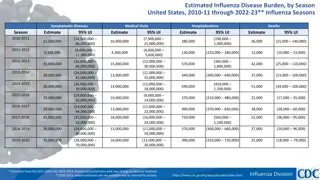



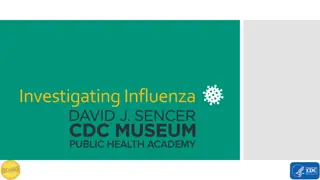
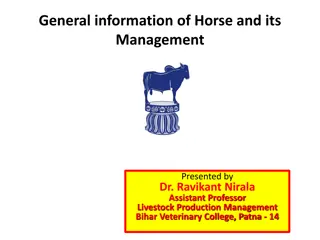
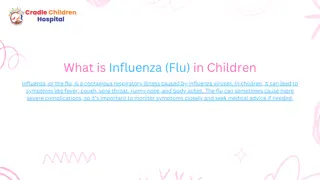
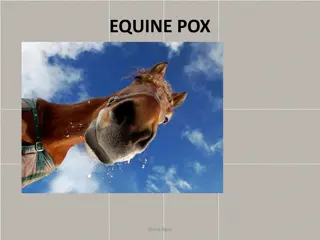


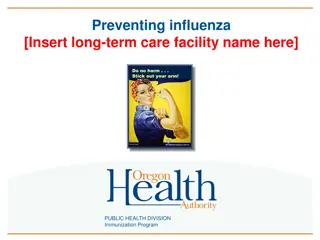

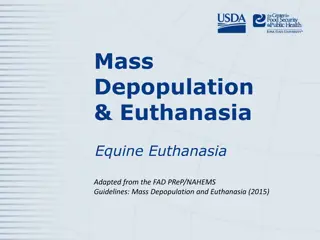
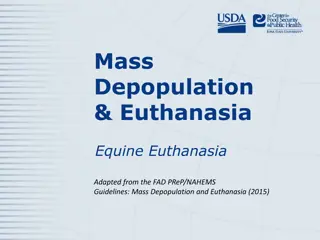
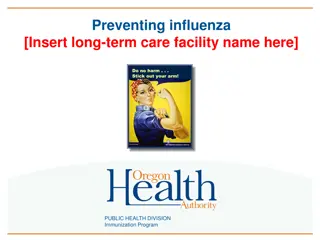
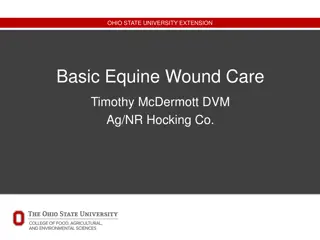
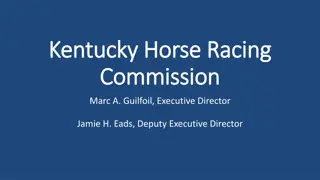

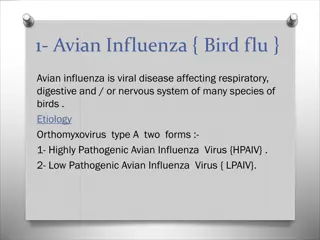
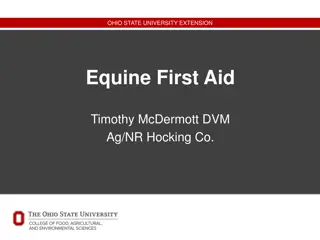
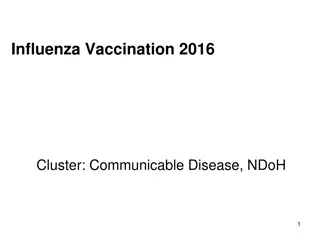


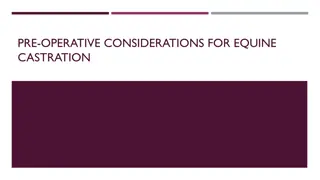

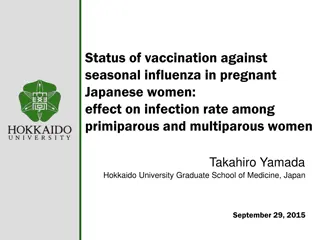
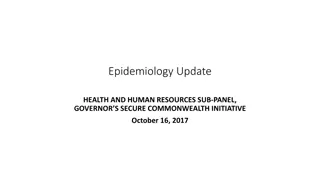
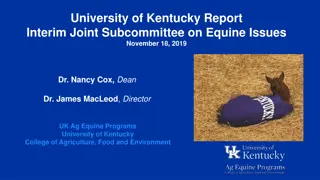
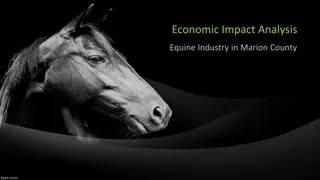
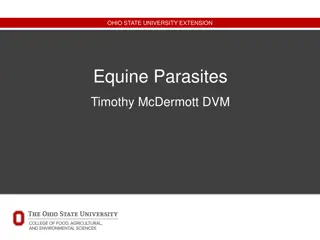
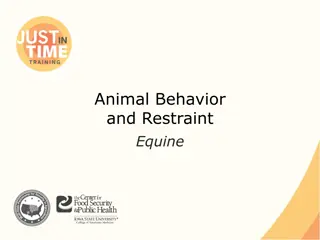
![Preventing Influenza at [Name of Critical Access Hospital]](/thumb/233818/preventing-influenza-at-name-of-critical-access-hospital.jpg)
